Campion Sail and Design
Plans available for the Apple 16 as a lug-rigged yawl or gaff cutter

Lug-rigged Apple
The design brief for the balanced lug rigged yawl version of the Apple:
To draw the largest traditional looking daysailer which could be built in a single car town garage. The finished hull of the Apple measured 15'10 oa by 5'3 over the gunwales. For those with limited time, means, but above all space, this design is well worth considering.
To draw the longest, deepest, widest hull possible, the planking for which would come out of a mere 4 sheets of 8' x 4' plywood through careful design and accurate nesting of the panel shapes, with one more sheet for the transom, semi-bulkhead, bulkhead and sunken foredeck, and an additional one for the long centre case, thwarts and knees. Naturally, some of the sailing gear such as the rudder stock, possibly the rudder, perhaps some floor stiffeners might call for a 9mm sheet as they may do on any design, but the aim was to use as little decent ply as possible for the bare shell for the open boat version so that anyone who has already built one or two boats might have useful off-cuts for the various smaller shaped parts already available. The version with extensive built-in buoyancy clearly demands several more sheets, but the need for buoyancy bags is obviated. The open boat version is both lighter and more traditional in style. If well ballasted, this open version can be comfortably sailed singlehandedly in style without sitting out. On the other hand, the ballasted half-decked version with greatly reduced open cockpit space is more suitable for open water. Ballast can be lead pigs or sand bags or water in built-in tanks.
To draw a shapely hull satisfying to the eye, with good step in stability; to have good heeled stability and manners for its type; to give a spirited sailing performance when raced against the local class racing dinghies; to easily accommodate up to 125kg of effective internal ballast for the single-hander who desires more the relaxed feel and ease of motion of a keelboat without the inconvenience of the keel; and to handle competently under oars.
To ensure that the hull is light enough to be man-handled, yet strong enough to help avoid puncture damage, the 6mm hull may be glass sheathed inside as well as out to increase strength, impact resistance and stiffness whilst ensuring an easily maintained surface.

Apple cutter photo courtesy of Erik Reinhard

This version has five planks each side so requires a little more ply, but the tumblehome transom can be had with the four plank version, too, by splitting the topside panel. Photo courtesy of P. Lord.

Here, with two men and 90kg almost 200lbs of ballast [which takes away the need to sit her out], it would only take one additional adult to bring her to her maximum displacement. In this guise with her crew of two, during the 2009 Raid Finland, 'Vips' finished only 15 minutes behind a much larger bermudian rigged centreboarder after a day long starboard tack beat in light winds, pointing as high and clearly almost as fast. That is pretty good going, Mr Lord! When rowing, only the twentyfour foot long Michalak 'Raider', pulling 3 oars, bettered her. As you might gather, Peter Lord is pretty pleased with his version of the Apple as a good all round raid boat.

Photo above and below courtesy of Wojtek Baginski.

Gaff rigged Apple
Photos of the Reinhard Cutter shown below are courtesy of Robin Reinhard and his father, Erik.

- Subscriptions
- Back Issues
- Instant Downloads
- Boat Plans & Kits
- Message Board
- Classifieds

Campion Sail: Tom Dunderdale’s ‘Apple’, et al.
by admin · May 10, 2010
I further modified the appearance of the design during construction to produce the boat in the photo by altering both deck camber and sheer, and building a different deck and cockpit layout – with in particular the narrow, sweeping side-decks and coamings – as well as a new high aspect-ratio semi- pivoting daggerboard, a high aspect ratio lifting rudder and a wider, more practicable tiller (all necessary as I intended racing the boat), and altered the rig twice – both during construction and a few months after. Most construction details are different, too. Further detailed changes were listed in ‘The Boatman’ review in the October/November issue of 1992.
The final appearance of the boat – though not the hull – is different to both Fisher’s digitised design and the original ‘Ethel’. Fisher’s modified version – which he named the ‘Lillie’ – follows Holmes’ original layout of deck and cockpit, low aspect centreboard and non-lifting rudder, but with his own rig; and it is this which he offers in his on-line catalogue – though illustrated with a photograph of the changed deck and cockpit of my boat.’
all material courtesy Tom Dunderdale/Campion sail and Design, unless otherwise noted
Tom Dunderdale’s elegant distillation of the British workboat, especially those from Cornwall, Kent and Sussex, really caught my eye. His flagship boat is the Apple and her plumb bow, lug yawl rig and raking transom hit home for me, but there are many iterations/variations. Conceived with an eye to tradition, the designer states:
Apple is a sweet-sheered, originally yawl-rigged, balanced lug day-sailer that has a surprising turn of speed. From her plumb bow to her raking transom, she has very much the air of a traditional boat, but her lines reflect modern thinking more than might at first be apparent. With the original small yawl lug rig layout she is exceptionally easily controlled with finger-tip-light steering at any degree of heel, showing the inherent balance of the hull form and will heel to some 40 degrees without driving the gunwale under when hard on the wind, remaining well mannered and docile. The flair of the forward sections tends to throw spray clear and she is surprisingly dry when sailed hard. Off the wind in a breeze, she lifts smoothly onto a plane without effort or fuss. In lighter airs, she slips along in a most satisfying manner, and will even sail herself for short periods if the sails are balanced carefully. For those who regularly sail in light wind areas, the large light weather mizzen makes for a truly stunning performance. And when the wind dies in the evening, she will row surprisingly well as the quarters are well lifted, the beam moderate and the weight surprisingly light thanks to the glass/ply/glass construction. Should a more sedate approach to sailing be required, the Apple will easily accommodate sand or shingle ballast bags as she has considerable carrying capacity without spoiling her sailing lines, and such disposable ballast ensures that easy manhandling ashore is not lost. Integral water ballast tanks can be built in to the decked version, too.
Apple was designed as a rewarding, handsome, open day-sailer for large lakes, rivers and sheltered estuary waters, one that could be built in a modest single car garage on a very modest budget yet would engender a real pride of ownership, with an ability and performance to entrance and enthuse her crew, most especially when sailing in company with modern craft, and not demoralize them with indifferent or poor sailing qualities once the novelty of sailing something ‘traditional’ has worn off. In her original open form, she is not, however, designed for cruising exposed coastal waters in strong winds – which is in keeping with other open or even partially decked designs, traditional or modern, old or new, including some supposedly able ‘cruising’ dinghies and dayboats – as it would be asking too much of such a light and almost totally open boat – and such a simple, inexpensive one – and probably of her crew, too. [But note that with the substantial reduction in open cockpit space as well as increase in weight to give the necessary momentum to punch through head seas, the decked, ballasted version is more suitable for open waters. The inherent exceptional balance of the design makes for far sweeter, easier handling than the hard-mouthed antics of some portly dayboats when over-pressed, whilst the ballast provides surprising power and stability with the crew inboard. There’s a general absence of slamming when driving hard through a short hollow chop with little thrown spray or when weaving through a confused head sea and partially luffing the crest and then bearing away down the back, whereas a full bowed ‘U’ sectioned boat in such conditions will stamp and slam if not stop, throwing spray, thin sheets or, if they’re really unfortunate, solid lumps of water at her luckless crew. In such conditions, a dry, well-tempered boat truly shines, and Apple is just that.] Within the constraints of the design, there really is little on the water that approaches her – she is handsome, able and distinctive.
Digging a little deeper into the Campion website (a word of warning: at first navigating the website is a bit like learning to drive in a foriegn country, challenging, but worth the effort) I discovered a wide range of delightful small boats, most of them with a traditional feel, and all drawn with the amateur builder in mind, using modern materials and construction techniques. With some of these designs, Tom offers a dizzying array of options, allowing the builder to tailor the boat he builds precisely to his needs. In addition to the Apple, I especially like the Pearl and Electra designs (see design notes above). I am so taken with the Pearl in fact, that, notwithstanding great designs by Oughtred, Welsford, Vivier and a covey of American designers, I’m ordering plans of Pearl. Of course, it’ll no doubt be a long time building, and I need to get my O’Day in this year. I’ve been corresponding with Mr. Dunderdale, both as a collaborator 0n this article and as a potential design client, and have found him forthcoming, generous and erudite.
Filed Under: Uncategorized
Add a Comment
Recent posts.
- Themed Issues —by Joshua Colvin
- The Child Inside
- Escaping on a 10-foot Sailboat
- Good Little Ship
- When Steering is a Drag
Recent Comments
- Terrance Watling on Bequia Beauty
- Marshall Weston on Boat Review: Flicka
- Allan Magee on A Conversation With Jerry Montgomery
- Peter Bristow on Pursuit of the Perfect Pram Continues (Readers’ Prams)
- Walter Yale on The Child Inside
- January 2018
- October 2017
- February 2017
- December 2016
- October 2016
- September 2016
- January 2016
- November 2015
- October 2015
- September 2015
- August 2015
- February 2015
- January 2015
- December 2014
- November 2014
- September 2014
- August 2014
- January 2014
- December 2013
- November 2013
- October 2013
- September 2013
- August 2013
- February 2013
- January 2013
- December 2012
- November 2012
- October 2012
- September 2012
- August 2012
- December 2011
- October 2011
- September 2011
- August 2011
- February 2011
- January 2011
- December 2010
- November 2010
- October 2010
- September 2010
- August 2010
- February 2010
- January 2010
- December 2009
- November 2009
- October 2009
- September 2009
- August 2009
- February 2009
- January 2009
- December 2008
- November 2008
- October 2008
- 70.8% (Thomas Armstrong)
- FETCH Across America (Kees Prins)
- General Posts
- R2AK Race to Alaska
- Rice's Southern Cross Voyage
- Uncategorized
'Salarøy is a 41' fembøring, a Norwegian workboat in Tromsø Norway. Courtesy Hildringstimens båtgalleri - http://www.hildringstimen.no/batlista.htm
Sunday, May 9, 2010
Campion sail: tom dunderdale's 'apple', et al..

tom- i don't make comments very often, but i love the pics. makes me want to move out to a pristine stark if lonely place and use these beautiful creations.
Post a Comment
a St. Paddy's Day

70.8%'s Fan Box

70.8%'s Bookstore
My blog list.

Links of Interest
- AK Ilen Company
- Albert Strange Association
- Mystic Seaport
- Small Craft Advisor
- Wooden Canoe Heritage Association
- Workshop on the Water
- Historic (98)
- Boatbuilding (67)
- Minimalist cruising (45)
- Workboats (40)
- Traditional (36)
- Designers (32)
- Small craft (32)
- Indigenous (31)
- Cruising (25)
- Kayaks (21)
- Mystic Seaport (18)
- Circumnavigation (16)
- Educational (16)
- preservation (15)
- environmental (13)
- Community (12)
- Ethnography (12)
- Junk Rig (12)
- Microcruising (12)
- Racing (12)
- Chesapeake (11)
- Liveaboard (11)
- Oughtred (10)
- Philosophy (10)
- Seasteading (10)
- (Very) Minimalist cruising (9)
- Independence Seaport Museum (9)
- Singlehand (9)
- WoodenBoat Show (9)
- for sale (8)
- Ecology (7)
- Canoe Yawl (6)
- Mingming (6)
- Proa and Outriggers (6)
- Sharpies (6)
- Tall Ships (6)
- WoodenBoat (6)
- Jester Challenge (5)
- Bretaigne (4)
- Catboats (4)
- Chesapeake Bay Maritime Museum MASCF (4)
- Festivals (4)
- Lug Rig (4)
- Scientific (4)
- AK Ilen (3)
- Albert Strange (3)
- Barnegat Bay (3)
- Beachcruising (3)
- Beaton's Boatyard (3)
- Boatbuilding Chesapeake Light Craft (3)
- CW Morgan (3)
- Catamaran (3)
- Fishing under sail (3)
- Historic Independence Seaport Museum (3)
- Kalmar Nyckel (3)
- Melonseed (3)
- Minimalist (3)
- Restoration (3)
- Wharram (3)
- AJ Meerwald (2)
- Antonio Dias (2)
- Bernard Smith (2)
- Bicycle (2)
- Christian Nielsen (2)
- Creed O'Hanlon (2)
- Denys Rayner (2)
- Dunkirk (2)
- Fishing (2)
- Laurent Giles (2)
- Michael Richey (2)
- Minimalist cruising John Welsford (2)
- Nomadness (2)
- Photography (2)
- Politics (2)
- Scotish Coastal Rowing Project (2)
- Surfing (2)
- Uffa Fox (2)
- Westerly (2)
- Whaleboats (2)
- Yacht Brokers (2)
- Amateur (1)
- Apprenticeshop (1)
- Assateague (1)
- Atlantic Challenge (1)
- Bronze casting (1)
- Concordia (1)
- Conor O'Brien (1)
- Estonia (1)
- Exploration (1)
- Finland (1)
- Frank and Margaret Dye (1)
- GL Watson (1)
- Gannon and Benjamin (1)
- Gavin Atkin (1)
- Giacomo De Stefano (1)
- HMS Bounty (1)
- Jack Tar Magazine (1)
- John Petersen (1)
- Jordan Boats (1)
- Lance Lee (1)
- MacNaughton (1)
- Man on the River (1)
- Maritime (1)
- Minimalist cruising Ben Seaborn (1)
- Morgan Launch. (1)
- Penobscot Marine Museum (1)
- Peter Henry Emerson (1)
- Pilot Cutter (1)
- Pride of Baltimore (1)
- Robert Tucker (1)
- Scottish Coastal Rowing Project (1)
- Summerwind (1)
- Taking off lnes (1)
- Technomad (1)
- Ted Kennedy (1)
- Traditional Scottish Coastal Rowing Project (1)
- Tremolino ProjectMystic Seaport (1)
- Tuckerton Seaport. (1)
- VeloOrang (1)
Subscribe To
Blog Archive
- ► May (1)
- ► October (2)
- ► August (2)
- ► July (3)
- ► November (1)
- ► October (3)
- ► August (1)
- ► July (2)
- ► June (1)
- ► April (2)
- ► February (2)
- ► December (1)
- ► September (3)
- ► August (4)
- ► July (4)
- ► June (2)
- ► May (3)
- ► April (3)
- ► March (3)
- ► February (3)
- ► January (3)
- ► December (4)
- ► November (4)
- ► October (5)
- ► September (6)
- ► July (8)
- ► June (5)
- Frank Dye passes
- Phoenix Rising: Silent Maid Sendoff
- 70th Anniversary Commemorative Return to Dunkirk
- News from Roger Taylor and Mingming
- Jester Challenge Preview
- Campion Sail: Tom Dunderdale's 'Apple', et al.
- Two Against Cape Horn
- MOTR: Advenure truly underway
- ► April (9)
- ► March (7)
- ► February (6)
- ► January (6)
- ► December (7)
- ► November (7)
- ► September (4)
- ► August (11)
- ► July (6)
- ► June (11)
- ► May (10)
- ► April (8)
- ► March (9)
- ► February (9)
- ► January (10)
- ► December (11)
- ► November (10)
- ► October (15)
- ► September (21)
- ► August (17)
- ► July (20)
Who links to me
Article Tag: campion
Campion’s apple 16.
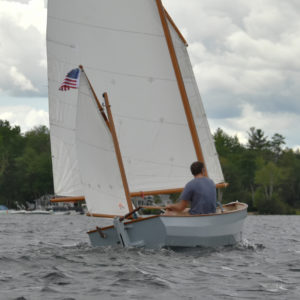
I t all started during the summer of 2015 when I decided that it was time to part ways with MAGIC, my 1962 Alberg 35′ glass sloop. I had spent four years and countless hours restoring MAGIC to her former glory, but two years after re-launching I needed a change. While she was not a big boat by today’s standards, the amount of time and money spent just keeping the boat in the water and in good condition was exhausting. The fact that I lived in central New Hampshire and kept the boat 150 miles away in southeastern Massachusetts only made things worse.
I found myself spending more and more time on a beat-up old O’Day Daysailer that had been following me around since college. My family and I romped around the local lakes and estuaries, sailing hard and often. The only money I spent on her was gas for the car and beer for the cooler. At some point that summer, I realized that I was having as much fun on the O’Day as I was on MAGIC, but with none of the stress. Sure, MAGIC was a comfortable boat that could take somebody sailing for weeks at a time, but I was mostly going out for day sails with an occasional overnighter. I could be doing the same thing on a much smaller boat.
At about the same time, I heard about the Small Reach Regatta, organized by the Downeast Chapter of the Traditional Small Craft Association in Maine. It’s not a race, but a gathering of small, traditional sailing and rowing craft. I have always been drawn to the look of classic boats and when I saw the boat lineup on the Small Reach Regatta website, I knew I had to check it out.
I showed up on the first morning of the event and was able to sail on Mike Duncan’s FRISKY LADY (a Chamberlin 15′ 6″ gaff sloop) and on Geoff Kerr’s NED LUDD, an Oughtred 19′ 6″ Caledonia yawl. I fell in love with the Caledonia but it was a bigger boat than I needed. However, the seed had been planted, and I spent the rest of the summer researching the perfect small boat in the range of 15′ to 18′.
The boat had to be pretty and, while I prefer the look of lapstrake, there is a lot of additional setup and framing required that takes a fair amount of time, so I was looking for a stitch-and-glue design that didn’t require a strongback and associated framing. I also like the classic look of a balanced lug-rigged yawl; and with unstayed spars, balanced lug rigs are really easy to set up for launching. The mizzen makes for easy handling. In spite of the appeal of classic boats, I wanted a fast boat, and a planing hull makes this possible.
The Apple 16, a five-strake stitch-and-glue balanced lug yawl designed by Thomas Dunderdale of Campion Sail and Design, came closest to being everything I wanted. The classic lines and balanced lug yawl were just what I was looking for and the somewhat flat aft section of the hull allows the boat to get up on a plane. I’m a sucker for a plumb bow, so as soon as I saw pictures of the Apple 16, I knew it was for me.
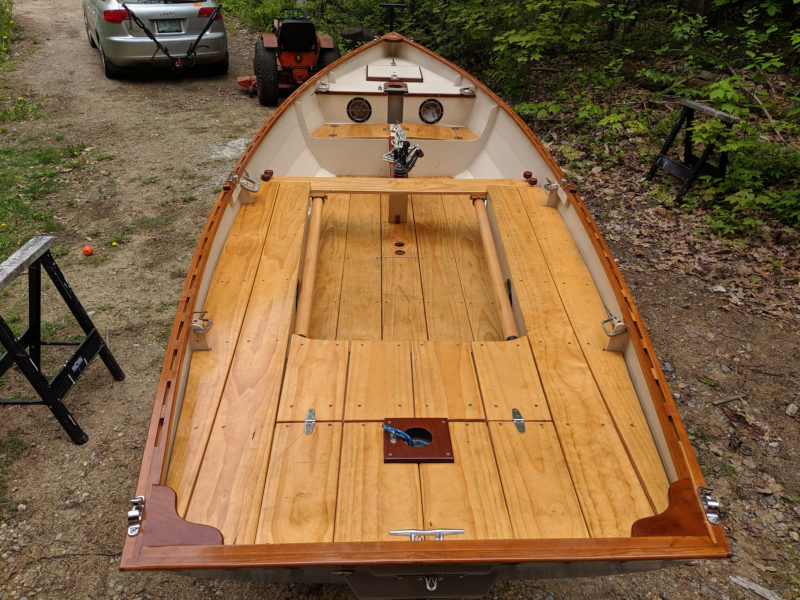
The plans detail several interior layouts, and provide the option for decked ends . The author designed his own interior with flotation tanks and a removable center thwart.
A fter several conversations with the designer, I purchased plans and began the build. Thomas was very helpful, answering all of my questions via email or phone.
I didn’t want to wait for a shipment of full-sized printed plans mailed from England; I opted for digital files and took them to a local copy shop and had them enlarged for about $30. I was really happy with the amount of thought and detail that went into the plans; they came with a general construction narrative, a detailed 30-page keyed construction index and at least a dozen schematics for the boat, parts, and interior layout options. For a first-time boat builder, everything provided should be easy to follow.
The included materials list calls for four sheets of 6mm marine plywood scarfed lengthwise for the hull, two sheets of 6mm for bulkheads and interior framing, and one sheet of 9mm for the rudder and additional components.
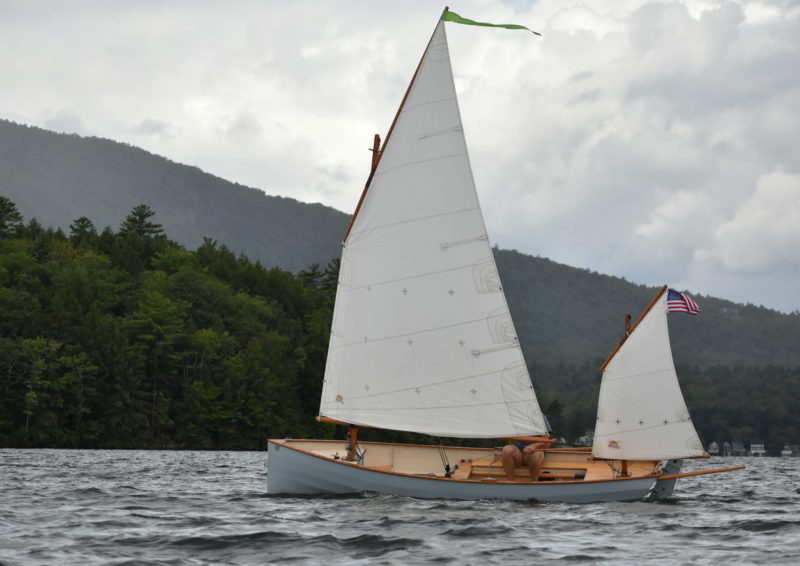
With a solo skipper aboard, the Apple 16 can, in spite of its traditional appearance and rig, get on plane in a moderate breeze.
While Campion does not currently offer files for a CNC mill, someone savvy with a CAD system should be able to digitize the planking measurements and send them off for cutting to save time. I don’t have easy access to a CNC mill, so I opted to plot the strakes on the scarfed panels and cut them out myself. The plans package provides both a table of offsets and a visual diagram for plank measurements that is very intuitive.
Probably the best thing about building a stitch-and-glue boat is how fast you can make visible progress. Once you cut the strakes from the scarfed plywood panels, assembling the hull is a simple matter of drilling out holes for wire or zip ties (I opted for zip ties) and stitching the panels together. In a single, albeit long, afternoon you can go from a pile of flat plywood pieces to a structure that resembles a boat.
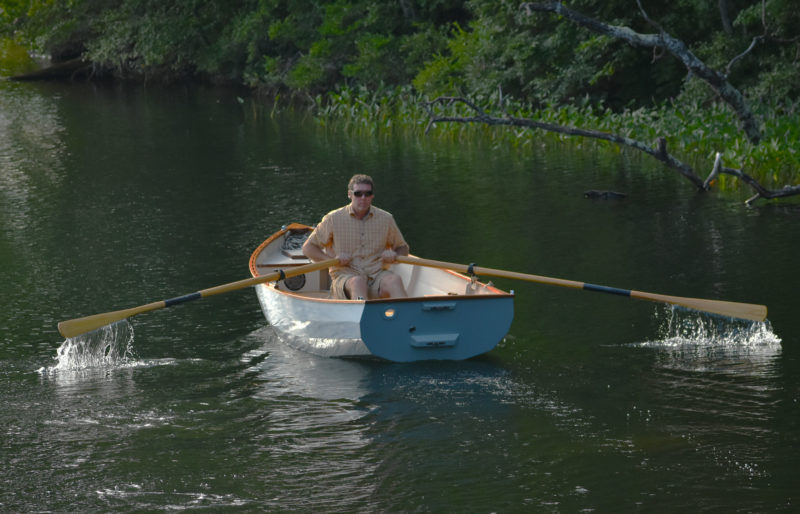
The author could comfortably row the Apple 16 at around 3 knots. His sectional oars, with carbon-fiber ferrules, stow neatly out of the way while sailing.
Of course, it’s not all a piece of cake. Until you get the bulkheads tied in, the entire structure is a bit of a wobbly mess. I cut cradles to steady and align it while I tied everything together. This helps immensely when one is working alone.
The job of taping the inside and outside seams, followed by a layer of 6-oz ’glass on the outside of the hull is rather monotonous. If you’re careful, cleanup should be a relatively minor job and once complete, you can move on to fitting out the interior.
The plans provide layouts for several interiors ranging from a spartan setup of three thwarts, with two doing double duty as mast partners, to a more extravagant layout with decks fore and aft. I deviated from the plans and designed my own interior with built-in flotation compartments and a center thwart that’s removable for camp-cruising.
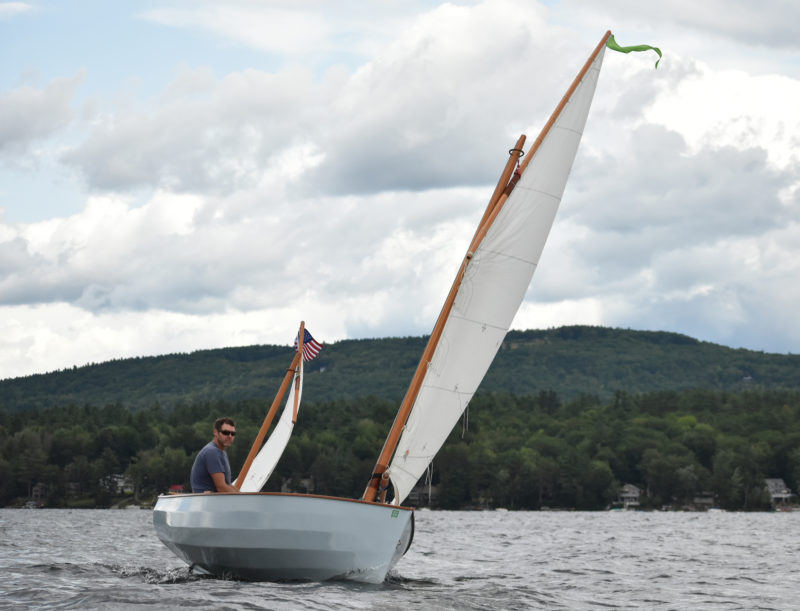
The boat is quite light, and a solo sailor could add some ballast to stiffen the hull against the press of the sails. The designer recommends adding between 110 to 275 lbs if ballast is needed.
The plans call for a long, open daggerboard trunk to accommodate multiple mizzen sail plans (the larger plan changes the center of effort and requires the daggerboard to be located further aft). Since I was only building the version with the smaller sail plan, I shortened the daggerboard trunk after consulting with Campion.
I also increased the thickness of the daggerboard from 25mm to 33mm so I could build a NACA 0012 foil. I’ve had several opportunities to test performance against other similar designs with balanced lugs and I believe that the foil helps with upwind performance.
All told, the build took me about eight months of working 10–15 hours per week, and I couldn’t be happier with the way it turned out. A single rower with 9.5’ oars can propel the boat at 3 knots when rowing at a comfortable pace, and her sailing ability has exceeded my expectations. Trailering with my four-cylinder Rav 4 is easy.
I ’ve had the boat out for dozens of times in a variety of wind conditions, and the boat is really amazing to sail. Having no prior experience with balanced lug rigs, I spent a lot of time researching balanced lug sail tuning and after a bit of trial and error, I opted to go with 6:1 downhaul and 4:1 mainsheet tackle. I used Dyneema line for the downhaul and main halyard to maximize luff tensioning ability.
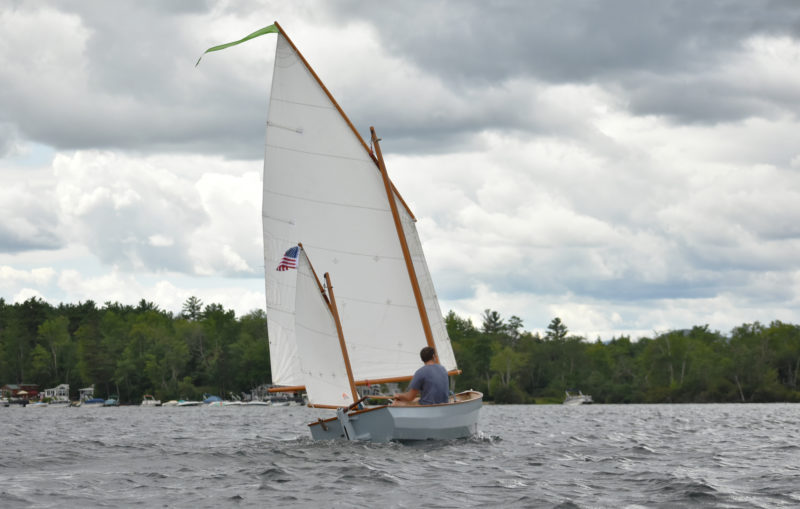
The Norwegian tiller may take a bit of getting used to if you haven’t used one before, but it is the simplest arrangement for getting around a mizzen mast and has a number of advantages over a conventional tiller.
With the rigging configuration sorted out and making sure the downhaul tension is drum tight, I found that the pointing ability was quite good. Combined with the foil daggerboard, which should theoretically increase lift, the Apple 16 is not far off the pointing angles that a similarly sized Bermuda-rigged boat can achieve. When soloing, I regularly get up on a plane on a reach and hit 8.5 to 9 knots in less than 15 knots wind. Over 15 knots and I put in a single reef, and have sailed in conditions up to 23 knots without being terrified.
We have had four adults out for a sail, and while it is manageable, two of the crew need to sit in the well on either side of the daggerboard trunk forward of the thwart. The 250-lb boat is really best suited for one or two, and each additional crew member reduces the boat’s ability to plane. I have yet to be able to get the boat on a plane with more than two crew on board; I suspect that it would have to be pretty windy to do so. With that said, the boat sails well even with four on board.
The boat is as well-mannered as a light boat can be and is reasonably dry in most conditions. Beating close-hauled into chop over 2’, predictably, tends to be the wettest point of sail. The yawl rig contributes to a very balanced helm on all points with just enough weather helm on the Norwegian push-pull tiller to take any of the play out of the system and allow you to make subtle course corrections.
Matt Bowser , a software engineer living in Canterbury, New Hampshire, can’t remember a time when he wasn’t obsessed with boats. He grew up sailing the coast of New England from Rhode Island to Maine and is enamored with the simplicity, ease, and low maintenance of small boats. When he isn’t sailing, building, or fiddling with various boat bits, he’s mountain biking in the forests of New Hampshire and Vermont or trying to get his teenage children to hang out with him.
Apple 16 Particulars
Length/15′ 10″
Waterline length/14′ 4-1/2″
Draft, board down/3′ 9″
Sail Area/123 sq ft
Ballast, if used/110 lbs to 275 lbs
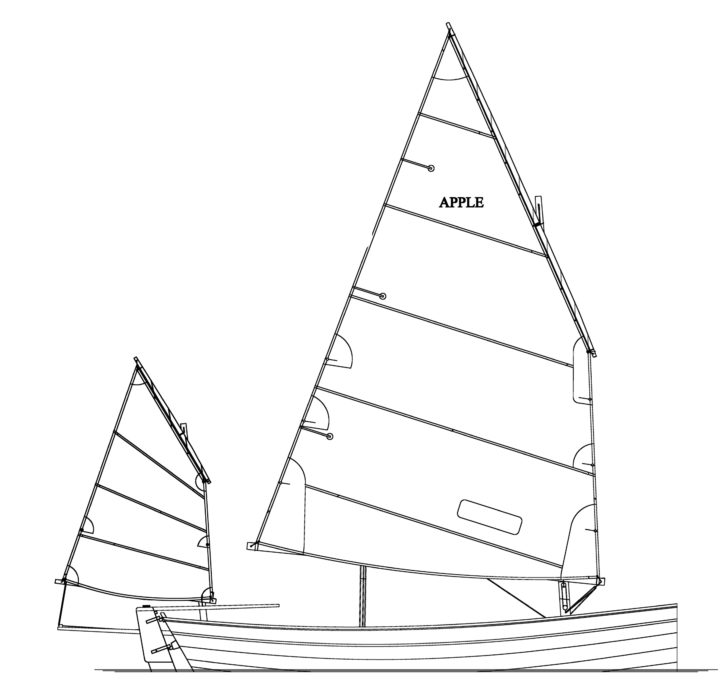
Plans for the Apple 16 are available from Campion Sail and Design , based in the UK. Prices are in Pounds Sterling: £65 (approx. $79 USD) for PDF, and £120 (approx. $146 USD).
Is there a boat you’d like to know more about? Have you built one that you think other Small Boats Magazine readers would enjoy? Please email us!
Subscribe For Full Access
Flipbooks are available to paid subscribers only. Subscribe now or log in for access.

IMAGES
VIDEO
COMMENTS
The Campion Apple is a well-thought-out small boat that is lively to sail. It’s a good choice for a first-time boatbuilder with woodworking skills.
A four plank aside half-decked Apple, gaff cutter rigged with tumblehome transom, sailing in the Alps photos courtesy E. Reinhard. Apple y...
After a lot of thought, and a few different abandoned directions (and several sets of plans), today I began building Tom Dunderdale's Campion Apple 16 (http://www.campionboats.co.uk/details.html). Here's a photo from the designer's website:
Melitele - my Campion Apple 16 Cutter. 10-05-2021, 02:48 AM. Hello everyone. I'm new here and building my first dinghy. It's Tom Dunderdale's Campion Apple 16. I've never done any work on a boat before so am learning as I go here.
Apple 16. Campion Sail and Design. as a lug-rigged yawl or gaff cutter. The design brief for the balanced lug rigged yawl version of the Apple: To draw the largest traditional looking daysailer which could be built in a single car town garage. The finished hull of the Apple measured 15'10 oa by 5'3 over the gunwales.
Apple is a sweet-sheered, originally yawl-rigged, balanced lug day-sailer that has a surprising turn of speed. From her plumb bow to her raking transom, she has very much the air of a traditional boat, but her lines reflect modern thinking more than might at first be apparent.
The Apollo 16 is a recreational sailboat, built predominantly of fiberglass. It has a fractional sloop rig with aluminum spars. The hull features a raked stem , a vertical transom , a transom-hung, kick-up rudder controlled by a tiller and a retractable, kick-up centerboard .
Apple is a sweet-sheered, originally yawl-rigged, balanced lug day-sailer that has a surprising turn of speed. From her plumb bow to her raking transom, she has very much the air of a traditional boat, but her lines reflect modern thinking more than might at first be apparent.
My Campion Apple 16 gaff cutter rigged dinghy project is my first attempt at building a boat. I'm fairly comfortable it'll float and sail, but there are definitely things I've learned along the way and there are plenty of "features" are really flaws, but I have to start somewhere :)
The Apple 16, a five-strake stitch-and-glue balanced lug yawl designed by Thomas Dunderdale of Campion Sail and Design, came closest to being everything I wanted. The classic lines and balanced lug yawl were just what I was looking for and the somewhat flat aft section of the hull allows the boat to get up on a plane.